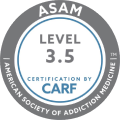Dilaudid is the brand name of a derivative of morphine that’s generically known as hydromorphone. It is a narcotic that’s regularly used as an analgesic, meaning doctors prescribe it as a painkiller. As is the case with many drugs derived from morphine, Dilaudid has a high propensity for both addiction and habit formation. Similarly, it carries with it a number of side effects, and the withdrawal and detox processes involving it can be very difficult for users to confront.
What Dilaudid Actually Does
Hydromorphone is synthesized from morphine, a drug that is itself a derivative of opium. It is classified as an opioid agonist. That means it is designed to activate opioid receptors in the brain, leading to a fairly quick-acting pain-relieving effect. It may also be utilized as a cough suppressant.
Dilaudid was first synthesized in 1921, and it was introduced to the market in 1926. Hundreds of studies have demonstrated its efficacy in treating pain.
What distinguishes hydromorphone from its close chemical relatives, like morphine, is that it is intended to act for a shorter period of time. As is the case with the majority of the drugs in its class, Dilaudid is meant to be taken in capsule form or via an orally consumed liquid solution. In some instances, mostly those involving patients who have developed high tolerances to opioids, the drug is delivered in an extended-release capsule or tablet. Although much less common, it is also occasionally administered via an injection.
Doctors are encouraged to only prescribe Dilaudid for moderate to severe pain, and for this reason, it is classified as a Schedule II controlled substance by the Drug Enforcement Administration. Most physicians prescribe Dilaudid to people who are suffering from:
- Cancer
- Burns
- Sudden onset pains
Generally, if a person is experiencing ongoing pain, he or she will be prescribed a different drug from the opioid class. The tendency to prescribe Dilaudid to folks who experience sudden pains is one of the factors that increases the risk of abuse of and addiction to this drug. In particular, some users make the mistake of doubling up missed doses when they’re advised to simply continue their regular schedules rather than doubling up. Likewise, measured oral administration can also lead to folks dosing themselves too strongly and forming tolerances. A tolerance to hydromorphone can develop within two or three weeks even when a person is using the proper dosing instructions.
Side Effects
Unsurprisingly, many of the potential side effects that follow Dilaudid are also ones that people who use other opioids often encounter. These include:
- Dizziness, drowsiness, and light-headedness
- Sweating
- Dry mouth
- Constipation
- Vomiting
- Nausea
In order to better regulate constipation side effects, a doctor may prescribe a patient a laxative or a stool softener. It’s also common for doctors to put their patients on diets that include increased fiber and extra water, and patients may be encouraged to engage in exercise, if possible. Many users of hydromorphone do not experience any side effects, but it’s wise to closely monitor your condition when on the drug and to contact your doctor if you notice any issues or if you have any questions.
More extreme side effects are often an indication that addiction is setting in and that withdrawal symptoms are occurring. These may include:
- Mood changes
- Hallucinations
- Altered mental states
- Confusion
- Agitation
Signs of physical problems can also emerge. You should watch for:
- Loss of appetite
- Severe stomach or abdominal pains
- Tiredness
- Weight loss
In some instances, those symptoms may indicate that something severe, such as a failure of the adrenal glands, has happened.
While allergic reactions are considered rare, you should pay attention to any signs that they might be occurring because such side effects can be very serious. You should get medical attention immediately if you notice:
- Rash
- Itching
- Swelling of the face, tongue, or throat
- Difficulty breathing
There are a number of pre-existing medical conditions that may lead to trouble while using hydromorphone. The doctor should be informed if you have previously experienced or if you currently have:
- COPD
- Kidney disease
- Liver disease
- Sleep apnea
- A head injury
- Tumors
- Seizures
- A mood disorder
- Stomach blockages or constipation
- Trouble urinating
- Pancreatitis
- Hypothyroidism
- Addison’s disease or any other malfunction of the adrenal glands
- Spinal issues
You should avoid all tasks that require alertness while on Dilaudid, including driving or operating machinery, and alcohol consumption should be avoided. If you or someone in your family has displayed signs of a substance use disorder, whether diagnosed or not, you should inform your physician before starting a Dilaudid regimen. Folks who have diabetes are also encouraged to show caution before going on the drug.
Dilaudid produces a high, and some people who’ve used the drug report feeling euphoria. Getting this feeling back is a common motivation for using higher doses or for seeking substitute street drugs.
Due to the possibility of breathing trouble, there is a risk that folks experiencing problems related to using Dilaudid may suffer cardiac or respiratory arrests. This has the potential to lead to death, usually as a result of an overdose. It’s suggested that a dose of Naloxone (Narcan), a drug designed to quickly reverse the effects of opioids in the body, be kept on hand if there’s any concern about a potential overdose occurring.
Withdrawal
Symptoms of withdrawal from hydromorphone can be triggered under a variety of conditions. Some users will not notice a problem until they’re taken off the drug. Others may notice issues when they’re moved onto another opioid.
The half-life of the drug ranges between two and three hours. That means that only half of the original amount of the drug will be present in that time if another dose isn’t taken. After four to six hours, the amount in a person’s system will be one-quarter and so on. Folks taking the extended-release version of the drug may see a half-life closer to eight to 15 hours.
Someone who has formed a chemical dependency may display withdrawal symptoms a few hours after the half-life time has been reached. Individuals whose dependencies are based on tolerance and who are seeking pain relief may experience symptoms sooner. Drug withdrawal symptoms may also appear in newborns whose mothers had been administered the drug, even if the mother does not appear to have formed a dependency herself.
One fortunate aspect of addiction to opioids is that they do not have lethal toxicities in themselves. It is the risk of respiratory or cardiac arrest that creates the potential for death. While withdrawal symptoms can be deeply uncomfortable and painful to experience, there is no risk of death due to withdrawal alone. Notably, there may be risk attached to withdrawal from some drugs that are commonly misused in conjunction with Dilaudid, especially alcohol and cocaine.
Virtually any of the previously listed side effects may also be exacerbated by withdrawal. Other signs that withdrawal due to chemical dependency is occurring include:
- Obsessing about getting another dose or a new prescription
- Purchasing the drug itself, another opioid, or an opiate illegally
- Seeking doses from other people who have prescriptions or old supplies
Possible physical indicators are:
- Disorientation
- Shaking
- Cold sweats
- Body cramps
- Muscle pains and body cramps unrelated to the condition that is being treated
- Diarrhea
- Vomiting
- Anxiety
- Returning pain from conditions that were suppressed
- Cravings
- Increased blood pressure levels
Some people who stop using the drug will also start using street drugs to replace it. Users may also engage in suicidal ideation or may attempt suicide. Others will try to guilt trip doctors or people they know who have access to the drug.
Detox
As previously mentioned, Dilaudid has a fairly short half-life. This means that the detoxification process will proceed fairly quickly once you have stopped taking new doses of the drug. To be more specific, the vast majority of the substance can be expected to be gone from your body within three days.
Folks who are suffering severe withdrawal symptoms may need to be monitored in a hospital setting. Some may also have to be weaned off the drug, and they may need to be moved onto another pain-relieving opioid. It’s not unusual for doctors to employ methadone in this role. Professionals also frequently switch patients to:
- Clonidine, a drug meant to curb symptoms without being intoxicating
- Buprenorphine, a partial opioid
- Probuphine, a slower-releasing version of Buprenorphine that’s administered over six months via an implant
Individuals who have a high risk of relapse may also be prescribed naltrexone, a drug that’s designed to prevent opiate effects from occurring in the brain. It can only be administered at the end of a full detox when the supervising physician has determined that the patient no longer has any opioids in his or her system.
Naltrexone has a strong enough record in treating the desire to consume drugs after the detox process, that it is also employed in treating folks who are quitting alcohol. That makes it an appealing option when treating patients who’ve abused drugs and alcohol or who’ve abused multiple drugs.
Some people will have extreme issues in kicking the habit using any type of opioid- or opiate-based drug, even those with good histories of fostering recovery. FDA approval has been given for Lucemyra (lofexidine hydrochloride), a drug that can be administered for up to two weeks. It may be helpful in assisting with an opioid taper or in treating symptoms without opioids involved in the detox method.
Inpatient care as part of a detox is usually short in length. A doctor will determine whether the patient is medically and psychiatrically fit to continue in an outpatient setting. If that patient is ready, he or she may be released to go home and to take up counseling on a scheduled basis. Those who have a high risk of relapse may instead be encouraged to enter a residential rehab program. This is a common option when a person’s peers or family may not provide suitable support for recovery.
Pain management issues for those who have ongoing problems, such as cancer or severe back pain, do not go away just because a person has kicked a hydromorphone habit. If that is your situation, you will need to work with a doctor who has experience with and training in prescribing medications to individuals who’ve had substance use issues. You should ensure that any future doctors you might work with regarding your pain management regimen are also fully informed about your previous history with opioids and addiction.
Regardless of the type of program a person goes through, relapse is also a real risk. The important thing, however, is to stay focused on getting better, even if you’ve had a relapse. With time, care, and counseling, it is possible to find a path forward from addiction.











